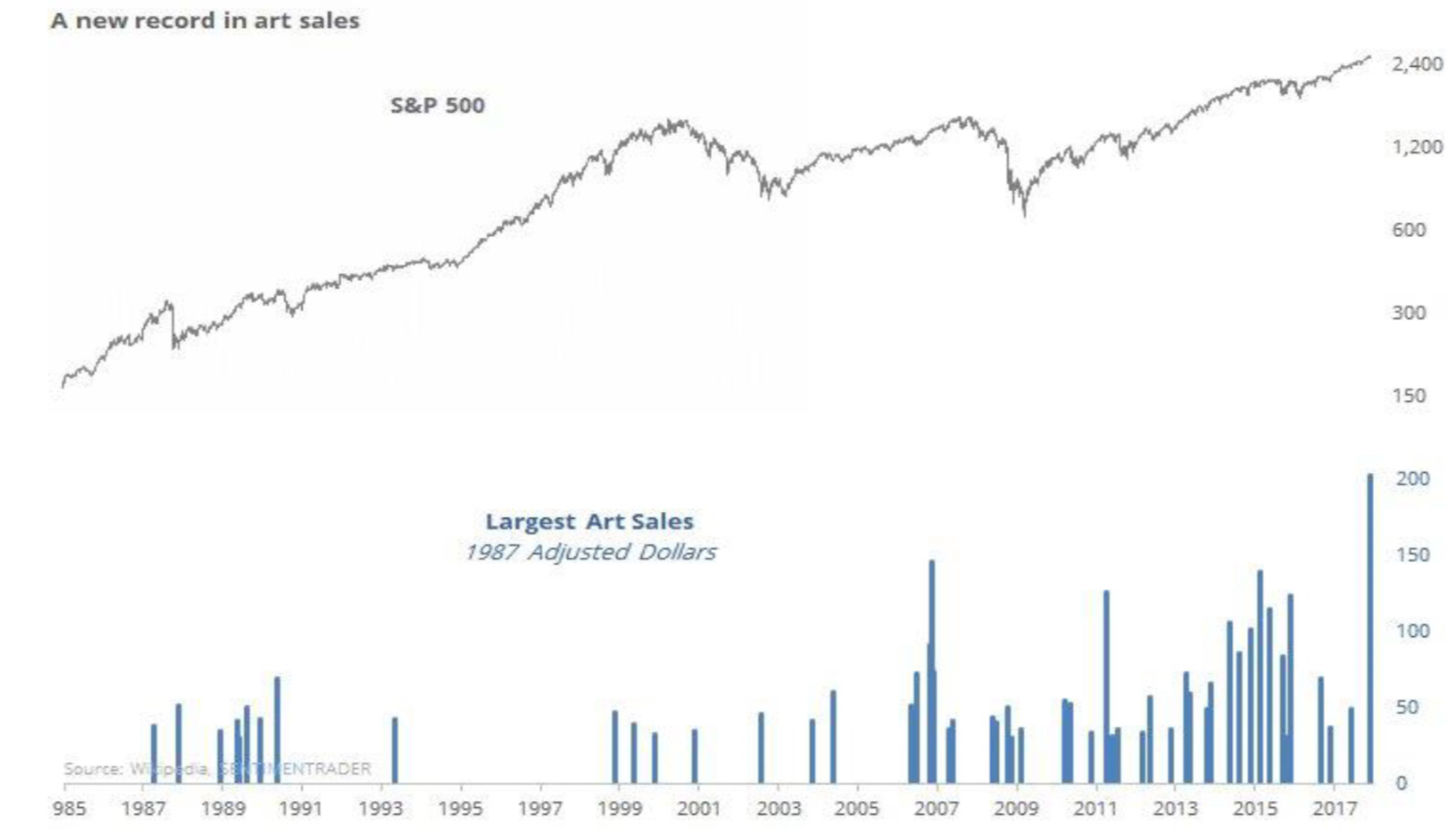Kunst als vorlaufender Blasenindikator
Die Auktion des – vermutlichen – Leonardo da Vinci Bildes für 450 Millionen US-Dollar vor zwei Wochen, hat weltweit für Schlagzeilen gesorgt. Es war nicht der einzige spektakuläre Auktionserfolg. 46 Millionen für einen zwölf Jahre alten Cy Twombly waren auch nicht schlecht. Insgesamt wurden 1,5 Milliarden bei Christie’s und Sotheby’s in der Woche umgesetzt.
Schon früher gab es solche Wellen. Übrigens immer parallel zu Tops an der Börse:
Eine Parallele, die auch anderen aufgefallen ist:
- “It screams late-cycle liquidity, recalling Japan’s impressionist fever in the late Eighties before the Nikkei collapsed and the bottom fell out of the art market.” – bto: Der Kunstmarkt als Indikator für Blasen an den Finanzmärkten? Ja, warum nicht.
- “Bitcoin clinches the argument. It has risen 1,200pc over the last year (…) on a ‚greater fool‘ presumption. This is not a criticism of blockchain technology. It will flourish. But you cannot yet buy and sell things in any meaningful way with cryptocurrencies now worth $180bn.” – bto: vor allem auch nicht, weil die Schwankungen so hoch sind. Das bedeutet, dass man nicht weiß, was etwas am Ende wirklich kostet.
- “A runaway asset boom can last a long time when the G4 central banks are holding real interest at minus 1.5pc and spending $2 trillion a year soaking up ‚safe assets‘ pushing investors into everything else. Yet we are past peak stimulus.” – bto: Das stimmt. Die Liquidität in den Märkten bläst wohl weltweit die größte Blase auf, die wir je hatten.
- “Academic bulls say the ‚stock‘ of central bank assets is still growing. Market bears counter that the ‚flow‘ is falling, which matters more to them. Hence the recent rout in high-yield credit.” – bto: Die Rate der Veränderung ist der entscheidende Hebel.
- “What threatens the universe of stretched asset values is the return of US inflation. The boom is built on the premise that ‚Goldilocks‘ lives on, and that the Fed will continue to bathe the dollarised global system with ample liquidity.” – bto: Es ist auch so. Wo immer man schaut, gehen die Beobachter von ewig tiefen Zinsen aus, einfach weil sonst die Blase platzt und der Schuldenturm kollabiert.
- “The New York Fed’s underlying inflation gauge has jumped to a post-Lehman peak of 2.96pc and is raising eyebrows among central bankers. This is one of the highest readings since the early 1990s.” – bto: Das Thema mit der möglichen Rückkehr der Inflation hatte ich ja schon mehrfach.
- “The Bank for International Settlements has issued repeated warnings on the likely transmission mechanism. Staccato rate rises by the Fed would ignite a dollar surge, squeezing an estimated $10.7 trillion of offshore dollar debt. There is a further $14 trillion of global dollar debt hidden in derivatives and FX swap contracts, pushing the total to $25 trillion. (…) The trades are plagued by currency and maturity mismatches. Most contracts must be rolled over every three months.” – bto: was wiederum sagt, dass es eben nicht passieren darf. Nur ob dies bedeutet, dass es nicht passieren kann?
- “(…) risk has migrated into non-bank finance from investment funds, pensions funds, and insurance companies through debt securities, creating a new feedback loop that could be just as dangerous. Open-ended funds often invest in illiquid assets but let investors withdraw money at short notice, creating a liquidity mismatch.” – bto: Das ist bekanntlich eine besonders gefährliche Situation, die rasch zu Pleiten führen kann bzw. massive Rettungsaktionen erfordert.
- “A rush for the exits would set off fire-sales. First movers acting cautiously – the ‚paradox of prudence‘ – create a self-fulfilling dynamic. (…) The global sums are huge. Open-ended fund assets in the eurozone alone have jumped from €4 trillion to €11 trillion since 2009. The structure is ‚pro-cyclical‘ and prone to herding behaviour.” – bto: weshalb es eben doch an den Börsen krachen kann, allen Beteuerungen der Bullen zum Trotz.
- “(…) the air is getting thinner for risk assets (…) triggers could be rise in earnings growth to 4pc, a rise in the ‚five-year/five-year breakevens‘ (a market measure of inflation expectations) to 3pc, and a rise in core PCE inflation to 2pc. If these happen, run for the hills.” – bto: Dann dürfte es zum Rennen zu spät sein.
- “(…) second worry is credit stress in China, setting off a fresh capital flight. Sophisticates may wish to short 12-month ‚forwards‘ in the offshore Chinese yuan. The rest of us should buy a few safe-haven bonds and pursue a ‚risk parity strategy‘, otherwise known as common sense.” – bto: Das sollte man sowieso machen.
- “This global expansion is the second longest since the mid-19th Century. It has been stretched because the recovery was so weak and because (…) it has been stretched by credit creation and this contains the seeds of its own destruction.” – bto: Die Hoffnung, die Probleme mit Gelddrucken zu lösen, führt zu einer Monsterblase, deren Platzen uns vor noch größere – dann wohl unlösbare – Probleme stellen wird.
- “The global debt ratio has jumped to a record 327 of GDP ($217 trillion), an increase of 51 percentage points even since the Lehman bubble. The world has even less tolerance for monetary tightening today. So does the market for red squiggles daubed with a pole.” – bto: Das ist bekannt. Nur stellt sich die Frage, ob es wirklich gelingt, lange so weiter zu machen. Ich bin skeptisch. Das wäre der ultimative Margin Call.








